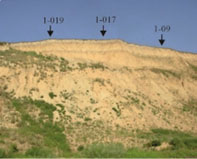Humus profile specificity of chernozems of the Ob river left bank within the Priob Plateau
DOI:
https://doi.org/10.31251/pos.v6i2.214Keywords:
humus profile; steppe soils; elementary humus-forming processes; parameters of humus substances; variation reason; Priobskoye Plateau.Abstract
Purpose of the study: to identify the features of chernozem humus profiles of the river Ob left bank within the Priob plateau (south of West Siberia) and the reasons that determined their diversity.
Place and time. The south of West Siberia (Topchikhinsky district of the Altai Territory), the north-eastern part of the Priobsky plateau, the steppe zone of the Pre-Altai province of the Kulundinsky-Aleysky district, the key site "Volodarka" on the eastern edge of the Porozikhinsky-Aleysky ridge (52°41-42' N and 83°38'E). Sampling was carried out annually in August.
Methodology. The collection and interpretation of materials are based on the principles and rules of the systems approach and soil ecology. The objects of study were southern and ordinary chernozems confined to different parts of the Volodarka key site (according to the soil classification of 1977; these classification names of soils are used in the text; according to the new Classification of Russian Soils (2004), the soils belong to the subtype of migratory-mycelial and textural-carbonate; according to WRB-2015 they are in the reference soil group Chernozems with the qualifiers calcic and siltic). The characteristics of humus profiles were obtained using traditional methods. All methods of analytical and instrumental study of humus and its individual components were identical. Methodological features of the research include detailed sampling (every 5–10 cm or less within the visual boundaries of the horizons) in late summer and the absence of strict methods for purifying preparations from mineral impurities. In this work, the concepts of “humus” and “system of humus substances” in soils are used as synonyms.
Main results. The humus profiles of the chernozems of the studied territory, currently functioning under the same conditions, have a significant variation in characteristics, representing a range of options typical for such soils (when, based on the combination of characteristics of elementary humus-forming processes - EHP - the upper part with the humification-transformation type of their structure and the lower one - with a transformation-migration type of combination of EHP), to varying degrees of structural complexity (when several parts are distinguished with different quantitative ratios of humus substances parameters with the predominance of their self-healing processes against the background of other EHP). The main characteristics of the studied buried paleosols lie within the limits peculiar to soils formed in temperature conditions optimal for humus formation, but different moisture conditions.
Conclusion. A significant difference in the qualitative and quantitative characteristics of chernozem humus profiles of the Ob river left bank within the Priob Plateau is due to both the complex history of the territory development, and different levels of self-healing capabilities of the natural open self-regulating humus substance system, depending on environmental conditions during the period of its formation. During complex history of the territory development different horizons of Middle Pleistocene soils came to the surface in different places, and therefore are found within the thickness usual for mature full-profile modern soils. The advantage of using humus profiles when analyzing the state of soils and the natural environment that forms them is the possibility of conducting a more detailed analysis of the variability of properties, the use of sediments and soils of different preservation, and identifying variations in environmental parameters even in the case of very short episodes of change in one or more soil formation factors or their individual characteristics, which are shorter in duration than the characteristic time required for the formation of the trait morphological expression. The materials presented in the work and their interpretation show that the information obtained about the soil state and the environment based on the study of soil humus profiles (the characteristics of which can be the results of studying the composition and properties of humus) has not lost its significance and can be used in solving a wide range of soil science problems including monitoring soil conditions, as well as substantiating forecasts of their behavior when changing environmental operating conditions.
Downloads

Downloads
Published
How to Cite
Issue
Section
License
Copyright (c) 2023 The Journal of Soils and Environment

This work is licensed under a Creative Commons Attribution 4.0 International License.






